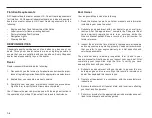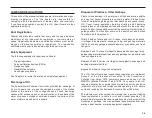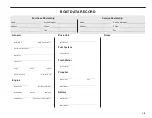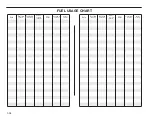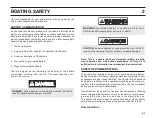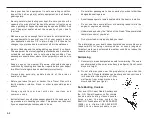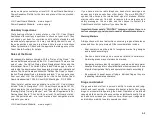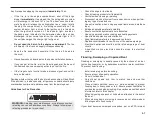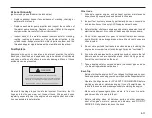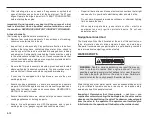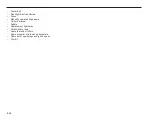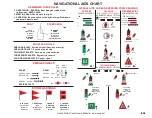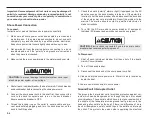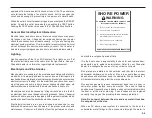
waters have visual distress signal equipment on board. In general,
coastal waters include all waters except rivers, streams, and inland
lakes. The Great Lakes are considered coastal waters as is a river
mouth more than two miles wide. Boats owned in the United States
and operating on the high seas must also carry visual distress
signal equipment.
Visual distress equipment must be in serviceable condition and
stowed in a readily accessible location. Equipment having a date
showing useful service life must be within the specified usage date
shown. Both pyrotechnic and non-pyrotechnic equipment must be
U.S. Coast Guard approved.
Pyrotechnic U.S. Coast Guard approved visual distress signals and
associated equipment include:
•
Red flares, hand held or aerial
•
Orange smoke, hand held or floating
•
Launchers for aerial red meteors or parachute flares
Non-pyrotechnic equipment includes an orange distress flag and an
S-O-S electric distress light.
No single signaling device is ideal under all conditions for all pur-
poses. Consider carrying various types of equipment. Careful
selection and proper stowage of visual distress equipment are very
important. If young children are frequently aboard, you should select
devices with packages which children, but not adults, will find diffi-
cult to open.
Sound Signaling Device
Your Chaparral boat must have a device that can produce a sound
signal when conditions require. For boats over 26 feet, the device
must be able to produce a two-second blast which can be heard a
mile away. For boats less than 26 feet, it must be able to produce a
two-second blast which can be heard one-half mile away. It can be
a hand, mouth or power operated horn or whistle. Refer to the U.S.
Coast Guard’s publication “Navigational Rules, International-Inland”
for details about the appropriate signals.
RUNNING AND NAVIGATION LIGHTS
Your boat must have running and navigation lights for safe opera-
tion after dark. Observe all navigation rules for meeting and
passing. Do not run at high speeds during night operation. Always
use common sense and good judgment.
SAFETY AFLOAT
Once your boat is launched and your excursion is underway, you
need to be aware of your surroundings and how they may affect your
safety and that of your passengers. There is no substitute for good
judgment and common sense.
Weather
Storms rarely appear without advance notice. Check the weather
forecast before you begin a day of boating. Be aware, however, that
weather conditions can change rapidly. If you have a marine radio,
listen to the weather reports issued by the U.S. Coast Guard and
others. If you have a portable radio, keep it tuned to a station broad-
casting frequent weather reports. Many boating clubs fly weather
signals. Learn to recognize these signals and listen to your local
forecasts before leaving port.
Your surroundings can also be a good indicator of changing weather
conditions. Watch for changes in wind direction or cloud formations.
There is no substitute for a good understanding of weather condi-
tions and what to do when the weather takes a turn for the worse.
Fog
Fog is a result of either warm-surface or cold-surface conditions.
You can judge the likelihood of fog formation by periodically mea-
suring the air temperature and dew point temperature. If the
difference between these two temperatures is small, fog is likely to
develop. Remember the following guidelines:
2-5
Содержание 2012 SSi
Страница 15: ...1 7...
Страница 16: ......
Страница 20: ......
Страница 49: ...3 14...
Страница 74: ...5 16...
Страница 75: ...5 17...
Страница 93: ......
Страница 101: ......
Страница 108: ...WIRING SCHEMATICS 12 12 1 196 206 216 SSI...
Страница 109: ...12 2 196 206 216 SSI...
Страница 110: ...12 3 226 SSI...
Страница 111: ...12 4 226 SSI...
Страница 112: ...12 5 246 SSI...
Страница 113: ...246 SSI 12 6...


